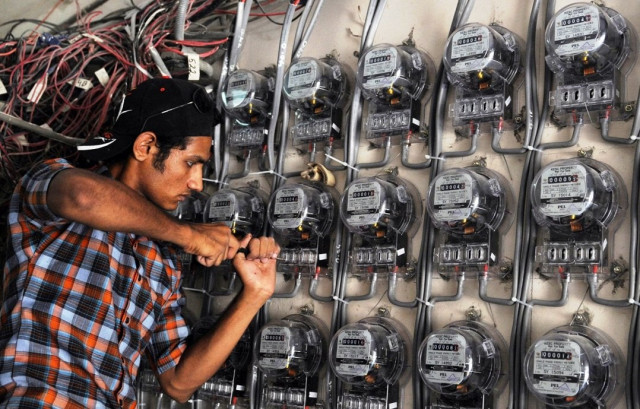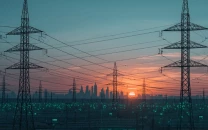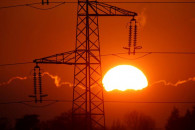Redesigning the smart meter project
Such meters help identify theft, reduce power sector losses

PHOTO: AFP
We would like to discuss government’s side of the issue, the mismanagement at distribution companies (DISCOs) and high transmission and distribution (T&D) losses including theft and receivables.
It has been estimated that around one-third of the cost of supply pertains to distribution cost and losses. A smart meter project had been conceived to detect and control electricity theft but it could not be implemented due to its inappropriate design and high cost.
After a lapse of a number of years, the smart meter project has emerged again without any required adjustment of the stakeholders. The main motivation behind installing smart meters is to control and prevent theft and improve receivables.
Smart meters enable a utility to monitor online consumer meters, penalise defaulters, cut off connection or release it. Meters are read automatically without meter readers, which in advanced countries is a major motivation for installing smart meters.
Smart meters are expensive. Pakistan’s resources are limited and there are other priorities in the power sector such as expanding the transmission and distribution system.
There is a need to redesign the smart meter project to increase its cost effectiveness and streamline implementation.
Stakeholders, therefore, demanded a more cost-effective approach in the project design. It was because of that reason the project suffered from delays in approval.
The lending agency did not show much sensitivity to concerns of the stakeholders and did not improve the project. Resultantly, the sponsoring ministry also went slow on it and decided to close the project.
With the change in government, the lending agency has managed to revive interest in the project. We would like to make some suggestions to improve the project, make it cost effective and enlarge its impact to the entire country.
Project redesign
It has been estimated that in order to have 90% coverage of the project consisting of 35 million consumers, at least $6 billion of capital expenditure (capex) and 6 to 10 years would be required.
Without coverage of 90-95%, the objectives of identifying and preventing electricity theft would not be achieved. The question is do we have that much time and money?
The smart meter project was designed under a governance regime which, like borrowing aimlessly, brought the result that we are all seeing today.
Certainly, project redesign is required involving a phased and time and cost-efficient approach. The alternative solution is to install smart meters (preferably along with a smart distribution transformer monitoring unit) on distribution transformers.
This would enable a utility to identify and measure electricity losses in areas covered by individual transformers. As opposed to 35 million meters (consumers), there are only 708,701 distribution transformers installed throughout the country (Nepra’s State of Industry report 2017-18).
It has been estimated that all distribution transformers would be covered with capex of $500 million under the current programme and it should be completed in two to three years. This would lead to the identification of transformers where considerable losses are borne.
Once high-loss (theft) transformers are identified, follow-up detailed monitoring and house-to-house search and meter inspection can be initiated. Hopefully and reasonably, 20% of distribution transformers may be identified under the first phase of the identification programme. In subsequent phases, the threshold may be reduced to include more transformers. Smart meters can then be installed on individual consumers who are suspected of theft.
Secondly, high-loss DISCOs should have been prioritised, which include Peshawar, Multan, Quetta, Hyderabad and Sukkur companies. Lahore and Islamabad electricity supplying companies have been selected, which are not high-loss companies.
Under a USAID programme, smart meters had been installed in areas covered by Peshawar and Multan electricity supplying companies as pilot projects. These pilot projects should have been upgraded, rather than initiating projects in areas of totally different DISCOs.
Apparently, no benefit is being taken out of these pilot projects. It is the job of government, the borrower, to make sure that right choices are made.
The Planning Commission has been making the aforementioned recommendations since the very inception of the project. Project promoters keep silent for a while and then restart on their beaten path again. Reportedly, Lahore Electricity Supply Company (Lesco) has invited bids for reevaluation of the project. It is the Power Division which should involve a third-party consultant to reexamine the project and recommendations of the Planning Commission.
Smart grid
The alternative project design would mark the beginning towards a smart grid. Smart meters can measure power quality parameters also, although it may require additional communication protocols and software to be able to analyse the power quality data sent by the smart meters installed on distribution transformers.
Additional sensors may be installed at other points as well. This would lead to a reduction in technical losses caused by power congestion and cables overheating.
While the aforementioned proposal has been around since 2016, Lesco and Islamabad Electricity Supply Company (Iesco) did not bother to consider it.
K-Electric has adopted it. It has been installing smart meters on its distribution transformers and has been able to identify high-loss transformers and is zeroing in on areas covered by such transformers.
It is now focusing on defaulters and stealers. In phase two, K-Electric will be installing smart consumer meters selectively on the basis of results obtained.
It would not be a blind exercise of installing smart meters everywhere but a considered and well-planned one. This would enable K-Electric to start getting results earlier with investment easing cash flow as well.
The Power Division would be advised to examine the smart meter distribution transformer system and try to convince the lending agency to replicate the K-Electric system, rather than continuing with the existing project design. Earlier it was an idea, now it is a reality and can be more convincing.
The Power Division has to start looking into problems of DISCOs and generation companies (Gencos). Corrective measures such as institutional and governance reforms are required.
While technical and institutional strengthening of the Power Division itself is an important requirement, alternative frameworks such as revival of Pakistan Electric Power Company (Pepco) may be considered with a larger mandate by including DISCOs and Gencos and a power planning and technology pool.
Pepco was dismantled on expectation that company independence and autonomy and an independent board of directors would be able to deliver. It has not happened.
Instead, the bureaucracy has managed to enhance its direct control over DISCOs and Gencos. Pooling of human resources is required to solve some common issues and problems.
The writer is former member energy of the Planning Commission
Published in The Express Tribune, May 18th, 2020.
Like Business on Facebook, follow @TribuneBiz on Twitter to stay informed and join in the conversation.



















COMMENTS
Comments are moderated and generally will be posted if they are on-topic and not abusive.
For more information, please see our Comments FAQ